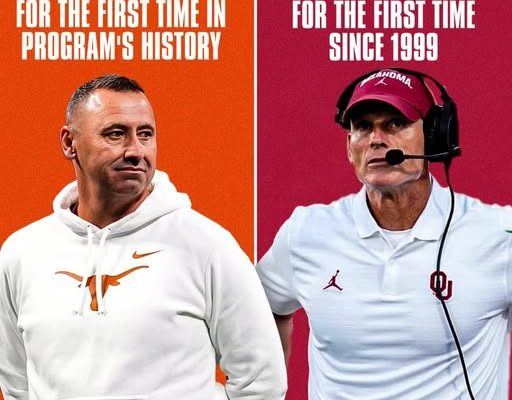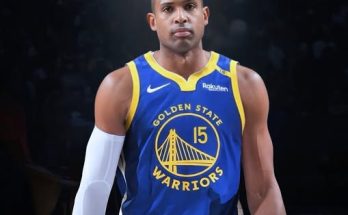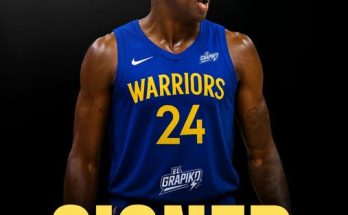The latest preseason college football poll has already sent shockwaves through the Big 12 and beyond, and the size of the gap between the Texas Longhorns and the Oklahoma Sooners is enough to fuel a rivalry that never really needs much stoking in the first place. For fans of both programs, this is more than just a number on a ranking list—it’s a statement, an early-season challenge, and a measure of how far one side has supposedly surged ahead in the eyes of analysts and voters. Texas, coming off a season that brought them back into the national spotlight, sits comfortably near the top, buoyed by an offseason full of recruiting wins, key returns, and national media buzz. Oklahoma, meanwhile, finds itself significantly further down the list, with questions swirling about roster turnover, new faces in key roles, and whether their recent struggles are a temporary blip or a sign of a bigger shift in the balance of power. The gap between them in this early poll is the largest it has been in recent memory, and that alone adds another layer of intrigue to a rivalry already defined by decades of close calls, high-stakes matchups, and mutual disdain.
To understand why the divide is so wide, it’s important to look at the trajectory of each program over the past few years. Texas has been building toward a moment like this, fueled by head coach Steve Sarkisian’s steady hand and ability to attract elite talent. The Longhorns have managed to combine raw athletic ability with a developing culture of discipline and resilience—something that has often been missing in the program’s recent history. The return of several key offensive weapons, combined with a defense that showed marked improvement last season, has given poll voters a sense that Texas is poised to compete not just for conference titles but for a spot in the College Football Playoff. The team’s strong finish last year, coupled with high-profile wins and recruiting coups, has created a momentum that is hard to ignore, and the poll reflects that.
Oklahoma, on the other hand, has been in a transitional phase under Brent Venables. While Venables has made strides in building a more balanced and defensively sound team, the Sooners have yet to fully reestablish the dominance they enjoyed during the Lincoln Riley era. The program’s storied offensive fireworks have been less consistent, and the defense—though improved—hasn’t been enough to mask the growing pains of a roster that has seen significant turnover. Oklahoma’s dip in the polls reflects skepticism about whether this team is ready to contend for a national title or even dominate the conference the way it once did. It’s not that the Sooners lack talent—they always recruit well—but rather that the pieces may not yet be in place to produce the kind of juggernaut performance fans have come to expect.
For Texas, this poll result isn’t just a pat on the back—it’s a warning shot to the rest of the conference and to their rivals up north. Being highly ranked before the season starts means expectations will be sky-high, and every opponent will be looking to take them down. In a rivalry game like the Red River Showdown, where records and rankings often mean little, being the higher-ranked team can be as much a burden as it is a badge of honor. The Longhorns will have to carry that weight, knowing that Oklahoma will see this ranking disparity as motivation to prove the voters wrong.
For Oklahoma, this is bulletin board material of the highest order. Venables and his staff now have a ready-made rallying cry: no one believes in us. In the culture of college football, perceived disrespect is often a powerful motivator, and the Sooners’ veteran leaders will no doubt be hammering that message home. The Red River rivalry has seen more than its fair share of upsets over the years, and there’s no doubt Oklahoma would love nothing more than to erase the preseason narrative with a statement win when the two teams meet.
Beyond the rivalry implications, this poll gap also speaks to the broader dynamics of college football’s ever-shifting landscape. Texas and Oklahoma are both on the verge of their move to the SEC, a transition that will bring a whole new set of challenges and opportunities. For Texas, entering the SEC as a top-tier program in the eyes of the media could help with recruiting, branding, and overall perception. For Oklahoma, lagging behind before making that jump could create doubts about how competitive they’ll be in the new environment. Both programs know that how they perform this year will set the tone for their debut seasons in college football’s toughest conference, and that adds another layer of urgency to their campaigns.
Texas’s rise in the poll is also tied to individual storylines that have captivated fans and media alike. Their quarterback situation appears stable and promising, with a starter who has shown poise under pressure and the ability to make big plays. Their offensive line, once a glaring weakness, has become a strength thanks to development and smart recruiting. The receiving corps is deep and talented, capable of stretching defenses and making clutch catches. On the defensive side, the Longhorns boast a front seven that can control the line of scrimmage, putting pressure on opposing quarterbacks and stifling the run game. These factors combine to create a team that, on paper, looks ready to handle whatever the season throws at them.
Oklahoma’s outlook is less settled. While there’s talent in the quarterback room, there are questions about consistency and big-game performance. The offensive line has undergone changes, and how quickly that unit gels will play a major role in the team’s success. The defense has shown improvement but will need to make more game-changing plays to keep pace with high-powered offenses. In many ways, the Sooners are a team in flux—talented enough to beat anyone on their schedule on a good day, but still searching for the kind of week-to-week reliability that defines elite programs.
History reminds us, however, that preseason polls are far from infallible. Many a team has entered the season riding high in the rankings only to stumble early, while others have started low and climbed to the top through sheer performance. For every Texas fan celebrating the gap now, there’s the understanding that it means nothing if the Longhorns don’t back it up on the field. For every Oklahoma fan frustrated by their placement, there’s the reminder that this program has a history of silencing doubters when it matters most.
The psychological aspect of this gap shouldn’t be underestimated either. For Texas, part of their challenge will be avoiding complacency. When everyone tells you that you’re better than your rival, it can be tempting to believe it and let your guard down. For Oklahoma, the challenge is channeling the frustration into focused, disciplined play rather than letting it lead to reckless mistakes. The Red River game in particular is often decided not just by talent but by which team handles the emotional swings better.
Recruiting will also be impacted by this preseason perception. High school prospects pay attention to rankings, and a significant gap can influence where they see themselves fitting in. Texas can sell the idea that they are on the cusp of national championship contention, while Oklahoma will have to sell the vision of being part of a resurgence—a role that can be equally appealing to the right kind of player.
The media, of course, will feast on this storyline. Every week leading up to the rivalry game will feature reminders of the gap, comparisons between players, and debates about whether Texas is truly that far ahead or if Oklahoma is being underestimated. Sports talk shows, podcasts, and social media will keep the conversation alive, ensuring that by the time the game kicks off, the stakes will feel even higher.
Ultimately, this preseason poll gap is just one chapter in the ongoing saga of Texas versus Oklahoma. It sets the stage for a season in which both teams will have plenty to prove—Texas, that they deserve the lofty expectations, and Oklahoma, that they are still very much a force to be reckoned with. No matter how the rest of the season unfolds, you can be sure that when the Longhorns and Sooners meet on that crisp fall day in Dallas, the gap in the rankings will be just one more reason for both teams to play their hearts out. The rivalry has always been about pride, passion, and bragging rights, and this year, thanks to an unusually large preseason divide, it might be even more intense than usual.
If Texas can maintain their ranking and back it up with dominant performances, they’ll head into the SEC transition with momentum and credibility that could reshape their place in the national conversation. If Oklahoma can close the gap—or better yet, leapfrog Texas by season’s end—they’ll remind everyone that no rivalry is decided on paper. Either way, this year’s preseason poll has given fans on both sides one more reason to circle the Red River Showdown on their calendars in bold red ink.



